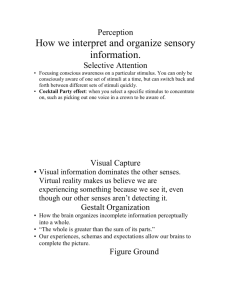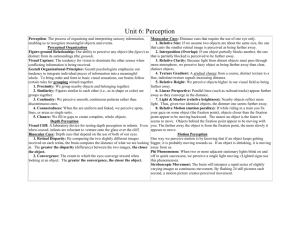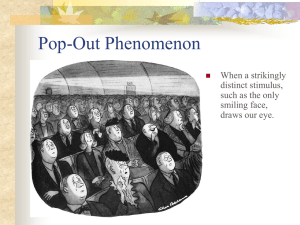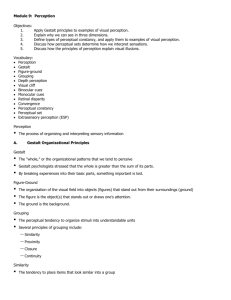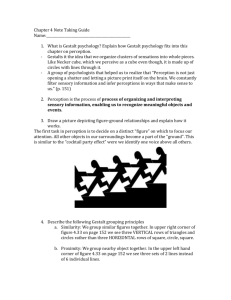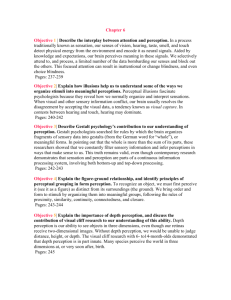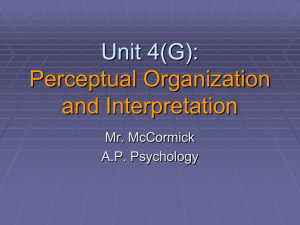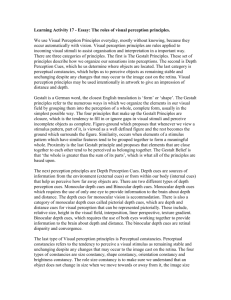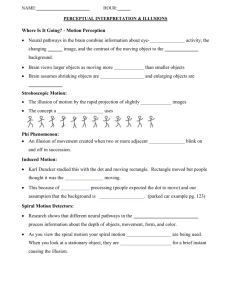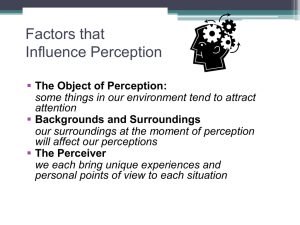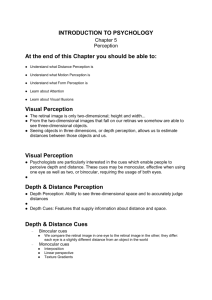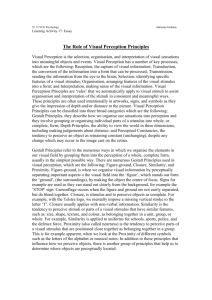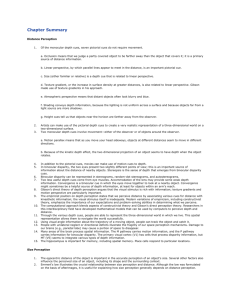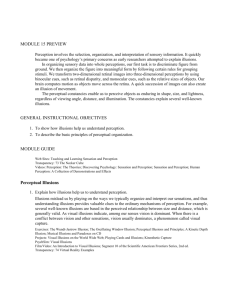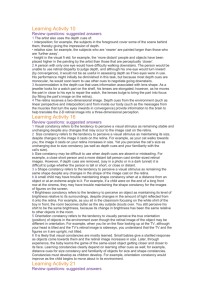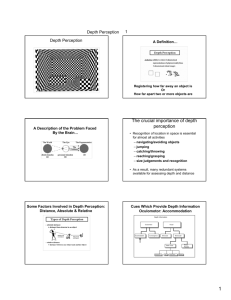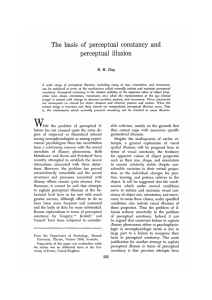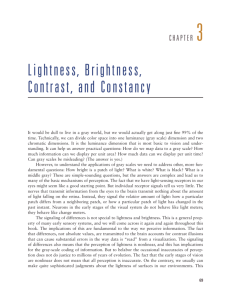Module 21 Perceptual Organization Module Preview Perception
advertisement
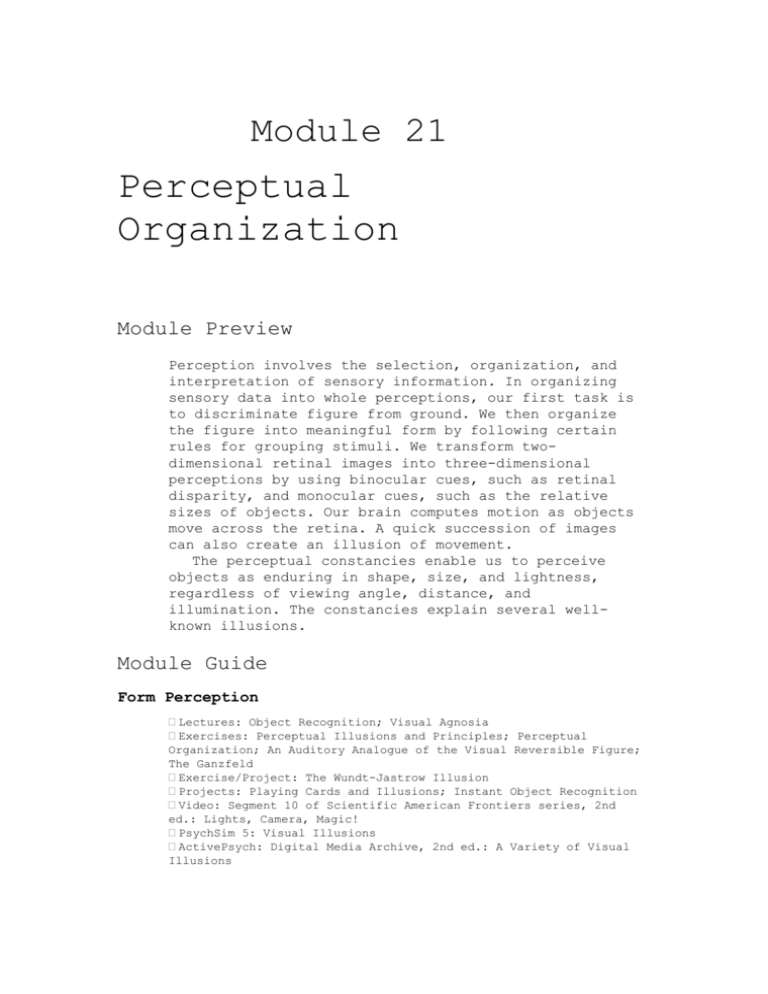
Module 21 Perceptual Organization Module Preview Perception involves the selection, organization, and interpretation of sensory information. In organizing sensory data into whole perceptions, our first task is to discriminate figure from ground. We then organize the figure into meaningful form by following certain rules for grouping stimuli. We transform twodimensional retinal images into three-dimensional perceptions by using binocular cues, such as retinal disparity, and monocular cues, such as the relative sizes of objects. Our brain computes motion as objects move across the retina. A quick succession of images can also create an illusion of movement. The perceptual constancies enable us to perceive objects as enduring in shape, size, and lightness, regardless of viewing angle, distance, and illumination. The constancies explain several wellknown illusions. Module Guide Form Perception Lectures: Object Recognition; Visual Agnosia Exercises: Perceptual Illusions and Principles; Perceptual Organization; An Auditory Analogue of the Visual Reversible Figure; The Ganzfeld Exercise/Project: The Wundt-Jastrow Illusion Projects: Playing Cards and Illusions; Instant Object Recognition Video: Segment 10 of Scientific American Frontiers series, 2nd ed.: Lights, Camera, Magic! PsychSim 5: Visual Illusions ActivePsych: Digital Media Archive, 2nd ed.: A Variety of Visual Illusions 21-1. Describe Gestalt psychology’s contribution to our understanding of perception, and identify principles of perceptual grouping in form perception. Gestalt psychologists described principles by which we organize our sensations into perceptions. They provided many compelling demonstrations of how, given a cluster of sensations, the human perceiver organizes them into a gestalt, a German word meaning a “form” or a “whole.” They further demonstrated that the whole may differ from the sum of its parts. Clearly, our brains do more than merely register information about the world. We are always filtering sensory information and inferring perceptions in ways that make sense to us. Our first task in perception is to perceive any object, called the figure, as distinct from its surroundings, called the ground. We must also organize the figure into a meaningful form. Gestalt principles for grouping that describe this process include proximity (we group nearby figures together), similarity (we group similar figures together), continuity (we perceive smooth, continuous patterns rather than discontinuous ones), connectedness (we perceive spots, lines, or areas as a single unit when uniform and linked), and closure (we fill in gaps to create a whole object). Depth Perception Lecture: Autostereograms Exercises: Binocular Vision Exercise/Project: Binocular Vision Versus Monocular Vision ActivePsych: Digital Media Archive, 2nd ed.: The Visual Cliff 21-2. Explain the binocular and monocular cues we use to perceive depth. Depth perception is the ability to see objects in three dimensions, although the images that strike the eye are two-dimensional. It enables us to judge distance. Research on the visual cliff (a miniature cliff with a drop-off covered by sturdy glass) reveals that depth perception is, in part, innate. Many species perceive the world in three dimensions at, or very soon after, birth. Binocular cues require information from both eyes. In the retinal disparity cue, the brain computes the relative distance of an object by comparing the slightly different images an object casts on our two retinas. The greater the difference, the greater the distance. Monocular cues enable us to judge depth using information from only one eye. The monocular cues include relative size (the smaller image of two objects of the same size appears more distant), interposition (nearby objects partially obstruct our view of more distant objects), relative height (higher objects are farther away), relative motion (as we move, objects at different distances change their relative positions in our visual image, with those closest moving most), linear perspective (the converging of parallel lines indicates greater distance), and light and shadow (dimmer objects seem more distant). Motion Perception 21-3. State the basic assumptions we make in our perception of motion, and explain how these perceptions can be deceiving. Our basic assumption is that shrinking objects are retreating and enlarging objects are approaching. The brain will also interpret a rapid series of slightly varying images as continuous movement, a phenomenon called stroboscopic movement. By flashing 24 still pictures a second, a motion picture creates perceived movement. The phi phenomenon, another illusion of movement, is created when two or more adjacent lights blink on and off in succession. Lighted signs exploit the effect with a succession of lights that create the impression of, say, a moving arrow. Perceptual Constancies Lecture: Auditory Organization Exercises: Variation in the Size of the Retinal Image; Perceived Distance and Perceived Size; Binocular Disparity and Size Constancy; Brightness Contrast Project: Perceived Lunar Size Videos: Video Clips 4 and 5 of Digital Media Archive: Psychology, 1st ed.: Müller-Lyer Illusion and Depth Cues 21-4. Explain how perceptual constancies help us to organize our sensations into meaningful perceptions. Perceptual constancy is necessary to recognize an object. It enables us to see an object as unchanging (having consistent shape, size, lightness, and color) even as illumination and retinal images change. Shape constancy is our ability to perceive familiar objects (for example, an opening door) as unchanging in shape, and size constancy is perceiving objects as unchanging in size, despite the changing images they cast on our retinas. Given the perceived distance of an object, we instantly and unconsciously infer the object’s size. The perceived relationship between distance and size is generally valid but, under special circumstances, can lead us astray. For example, one reason for the Moon illusion is that cues to objects’ distances at the horizon make the Moon behind them seem farther away. Thus, the Moon on the horizon seems larger. In the distorted (trapezoidal) room designed by Adelbert Ames, we perceive both corners as being the same distance away. Thus, anything in the near corner appears disproportionately large compared with anything in the far corner. Lightness constancy enables us to perceive an object as having a constant lightness even when the light that falls on it changes. Perceived lightness depends on relative luminance, which is the amount of light an object reflects relative to its surroundings. Color constancy refers to our perceiving familiar objects as having consistent color, even if changing illumination alters the wavelengths reflected by the object. We see color as a result of our brain’s computations of the light reflected by any object relative to its surroundings.
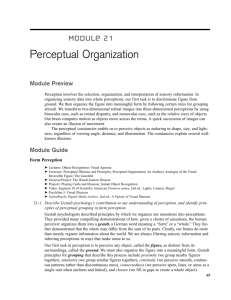
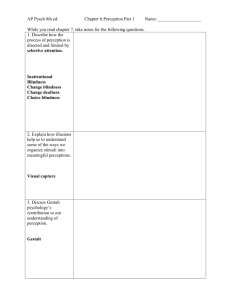
![PERCEPTION powerpoint[1].](http://s3.studylib.net/store/data/009457343_1-6b71423308f582839d1485b3b84f87a3-300x300.png)
